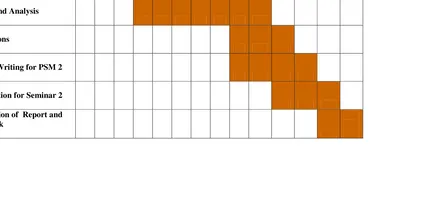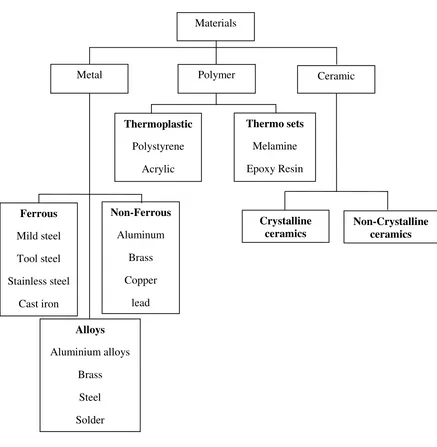ANALYSIS ON BICYCLE CRANK ARM USING TENSILE TEST
SHAIFATUL SHIMA BINTI SHAARI
This report is submitted in partial fulfillment of the requirement for the Degree of Bachelor of Mechanical Engineering
(Design & Innovation)
Faculty of Mechanical Engineering Universiti Teknikal Malaysia Melaka
(Design & Innovation)
Signature : ……….
Supervisor’s I Name : ……….
i
ACKNOWLEDGEMENT
Assalamualaikum, firstly I would like to thanks God because on his mercy I finally able to complete my final year project of Analysis on Bicycle Crank Arm Using Tensile Test. I would like to express my deepest appreciation to my supervisor Mr Asri Bin Yusuff, and also for his invaluable support, guidance, encouragement, criticism, and insight throughout the research. It was a great pleasure for me to work with him. And also to Miss Siti Nor Baya Binti Sahadan as my mentor for helped me to finished up this project.
For many valuable encouragements and discussions on my project, I am indebted to my colleagues at Universiti Teknikal Malaysia Melaka (UTeM), who has also involved during the project. I am also grateful to all technicians from structure department especially to Mr Rashdan Bin Seman who has been an indefatigable advisor; teach the procedure for my experiment which include to handling the machine and all the equipment in the laboratories for helping me in my final year project.
ABSTRACT
The mechanical properties of a material are directly related to the response of the material when it's subjected to mechanical stresses. The results of tensile tests are used in selecting materials for engineering applications. Tensile properties frequently are included in material specifications to ensure quality. Tensile properties often are measured during development of new materials and processes, so that different materials and processes can be compared. Since characteristic phenomena or behavior occur at discrete engineering stress and strain levels, the basic mechanical properties of a material are found by determining the stresses and corresponding strains for various critical occurrences. A wealth of information about a material's mechanical behavior can be determined by conducting a simple tensile test for bicycle crank arm of uniform cross-section is pulled until it ruptures or fractures into separate pieces. Finally, tensile properties often are used to predict the behavior of a material under forms of loading other than uniaxial tension. This mechanical testing was done by using Instron 8802 Dynamic Machine. Based on the initial geometry of the sample, the engineering stress-strain behavior (stress-strain curve) can be easily generated from which numerous mechanical properties, such as yield strength and elastic modulus, can be determined. The major parameters that describe the stress-strain curve obtained during the tension test are the tensile strength (UTS), yield strength or yield point ( y), and elastic modulus (E). By using the X-Ray Diffractormeter, it can determine the types of material which include in the bicycle crank arm.
iii
ABSTRAK
LIST OF CONTENTS
CHAPTER TITLE PAGES
ACKNOWLEDGEMENT i
ABSTRACT ii
LIST OF CONTENTS iv
LIST OF TABLES vi
LIST OF FIGURES vii
LIST OF SYMBOLS xi
CHAPTER 1 INTRODUCTION
1.1 Introduction 1
1.2 Objectives 5
1.3 Problem Statement 5
1.4 Scope of the Research 6
CHAPTER 2 LITERATURE REVIEW
2.1 An Overview of Metal Structure 8
2.2 Introduction to Material Testing and Mechanical
Properties of Metal Structure 14
2.3 Fatigues in Metal Structure. 14
v
CHAPTER 3 METHODOLOGY
3.1 Introduction 22
3.2 Material and Specimen Preparation 24
3.3 Method of Mechanical Testing 26
3.4 Method of Calculation 40
3.5 Material Analysis via X-Ray Diffractormeter 44 (XRD)
CHAPTER 4 RESULT AND DISCUSSION
4.1 Introduction 48
4.2 Result of Tensile Test 48
4.3 Result of X-Ray Diffractormeter (XRD) 59
CHAPTER 5 CONCLUSION AND RECOMMENDATION
5.1 Conclusion 60
5.2 Recommendation 62
REFERENCES 63
BIBLOGRAPHY 64
LIST OF TABLE
BIL TITLE PAGES
1.1 Gantt chart PSM 2 7
3.1 INSTRON 8802 Machine Specification 27
(Source: UTeM Laboratory)
vii
LIST OF FIGURE
BIL TITLE PAGES
2.1 Flow for different types of material 9
(Source: Mortimer, 1975)
2.2 Typical fatigue-failure surfaces. 16
(Source: Chalmers, B. 1986)
2.3 Intrusion-extrusion model of fatigue crack initiation. 17 (Source: Roylance, D. 2001)
2. 4 Part of Bicycle 19
(www.wikipedia.com)
2.5 Flow of Mechanical Properties of Composite Material 21
3.1 Process Flow Chart of Research 23
3.2 Flow of Material Preparation 24
3.3 Part of Bicycle Crank Arm 25
(Source: www.wikipedia org)
3.4 Instron 8802 Machine 26
(Source: UTeM Laboratory)
3.5 Extensometer 28
(Source: www.tensiletest.com)
3.6 Schematic illustration showing how the sample is tested using
extensometer 29
(Source: www.composite.tensile.com )
3.7. Bicycle Crank Arm 32
(Source: UTeM Laboratory)
3.8 Measurement and marked the specimen 32
ix
3.10 Position of bicycle crank arm during tensile test 33
3.11 Side view of bicycle crank arm 34
3.12 A close up view of bicycle crank 34
3.13 BLUEHILL Software 35
3.14 Example of graph to show the point of yield point,
Maximum load and load at break 42
3.15 X-Ray Diffractormeter Machine (XRD) 44
3.16 Specimen on the stage 47
3.17 Machine in operation 47
4.1 Bicycle Crank Arm before Tensile Testing 50
4.2 Bicycle Crank Arm after Tensile Testing 50
4.3 A close up view of the bicycle crank arm before and after
tensile test 50
4.4 Graph of Load, kN versus extension, mm under tensile test for
4.5 Graph of Stress, MPa versus Strain, % under tensile test for
bicycle crank arm. 53
4.6 Graph Stress, MPa versus Strain, % under tensile test for
bicycle crank arm with other value 54
4.7 The region of stress-strain curve for bicycle crank arm under
xi
LIST OF SYMBOLS
= True Strain = True Stress, Pa
S = Engineering Stress, Pa
e = Engineering Strain
P = Load, N
A = Area, m2
L = Length, m
l0 = Original Gage Length, m
lf = Final Gage Length, m
tf = Final Thickness, m E = Modulus Elasticity
CHAPTER 1
INTRODUCTION
1.1 Introduction
2
The selected material was choosing is crank arm for paddle bicycle. This material is structural material which consists of combining two or more constituents. Normally, cranks are constructed of an aluminum alloy, titanium, carbon fiber, chromoly steel, or some less expensive steel.This crank arm is the component of the bicycle that transfers the force exerted on the pedals to the crank set. Crank arms can crack in a number of places. Sometimes a crack will develop between the pedal mounting hole and the end of the arm. A crack also will develop at the crotch of the chaining-mounting arms (spider arms) and the crank arm.
The effects of dynamic loading are probably the most important practical part of the strength of bicycle crank arm, especially the problem of fatigue. Repeated loading often initiates brittle cracks, which grow slowly until failure occurs. However, the term strength of materials most often refers to various methods of calculating stresses in structural members. The methods that can be employed to predict the response of a structure under loading and its susceptibility to various failure modes may take into account various properties of the materials other than material (yield or ultimate) strength.
Most crucial structures subjected to fatigue failures in metallic structure are a well-known technical problem. It is of great importance for engineers the time a fatigue crack will take to grow from initial size to the critical value in designing structures and determining inspection intervals. Failures apparently occurred without any previous warning.
Fatigue of materials is a well known situation whereby rupture can be caused by a large number of stress variations at a point even though the maximum stress is less than the proof or yield stress. The fracture is initiated by tensile stress at a macro or microscopic flaw. Once started the edge of the crack acts as a stress raiser and thus assists in propagation of the crack until the reduced section can no longer carry the imposed load. While it appears that fatigue failure may occur in all materials, there are marked differences in the incidence of fatigue.
4
1.2 Objectives
The objectives of this research are:
a) Learn to conduct an experiment related with tensile test.
b) To analyze the effect of constant load to the bicycle crank arm structure. c) To study and analyze the material properties of the bicycle crank arms.
1.3 Problem Statement
6
1.4 Scope of the Research
This research comprises of the following scope:-a) To do literature study on metal structure. b) To carry out tensile test on bicycle crank arm. c) To anaylize affect to the structure
TABLE 1.1: GANTT CHART FOR PSM 2
FINAL YEAR PROJECT TITLE:
ANALYSIS OF BICYCLE CRANK ARM USING TENSILE TEST
RESEARCH ACTIVITY/TIME
JANUARY 2010 FEBRUARY 2010 MARCH 2010 APRIL 2010
W1 W2 W3 W4 W5 W6 W7 W8 W9 W10 W11 W12 W13 W14
1) Mechanical Testing
2) Result and Analysis
3) Discussions
4) Report Writing for PSM 2
5) Preparation for Seminar 2
6) Submission of Report and Log Book
[image:20.595.153.733.196.475.2]
8
CHAPTER 2
LITERATURE REVIEW
2.1 An Overview of Metal Structure.
Material can be anything a finished product in its own right or an unprocessed raw material. Raw materials are first extracted or harvested from the earth and divided into a form that can be easily transported and stored, then processed to produce semi-finished materials. These can be input into a new cycle of production and finishing processes to create finished materials, ready for distribution, construction, and consumption. In chemistry materials can be divided into two which is metals and non metals.[1]
2.1.1 Types of Metal
This is one of the three groups of elements in materials. Some metals and metal alloys possess high structural strength per unit mass, making them useful materials for carrying large loads or resisting impact damage. Metal be divided into three which is ferrous, non ferrous and alloys.[2]In this research the main objective is to analyze the metal structure.
Figure 2.1: Flow for different types of material (Source: Mortimer (1975))
Thermoplastic Polystyrene Acrylic Thermo sets Melamine Epoxy Resin Ferrous Mild steel Tool steel Stainless steel Cast iron Non-Ferrous Aluminum Brass Copper lead Alloys Aluminium alloys Brass Steel Solder Materials
Metal Polymer Ceramic
Crystalline ceramics
[image:22.595.106.543.240.687.2]10
2.1.1.1 Ferrous
Ferrous metals are those metals which contain iron. They may have small amounts of other metals or other elements added, to give the required properties. All ferrous metals are magnetic and give little resistance to corrosion. Most commonly used ferrous metals are mild steel, high speed steel, stainless steel, high tensile steel and cast iron.[1]
2.1.1.2 Non-Ferrous
Non ferrous metals are those metals which does not contain iron. They are not magnetic and are usually more resistant to corrosion than ferrous metals. Most commonly used non ferrous metals are aluminium, copper, brass, lead, tin, gilding metal and zinc.[1]
2.1.1.3 Alloys
2.1.2 Metallic Properties.
Metals are usually shiny solids with high melting points and are very good conductors of heat and electricity. They are malleable, so they can be beaten into sheets, and ductile, which means they can be drawn into wires. Most are strong and cannot be broken easily. Mercury, for example, is a metal that has a low boiling point and is liquid at room temperature.[1]In general metal have:
1. Density 2. Ductility
3. Thermal Conductivity 4. High electric

